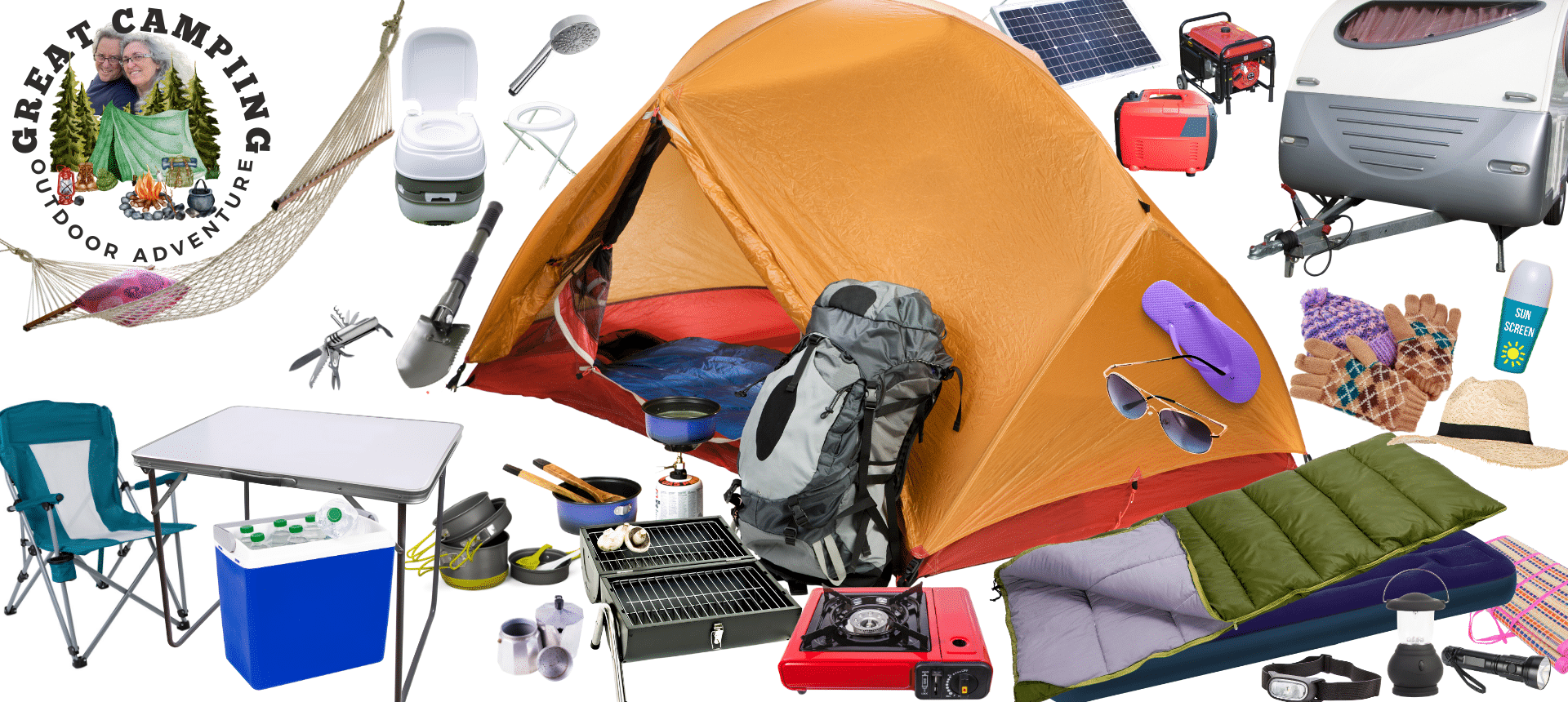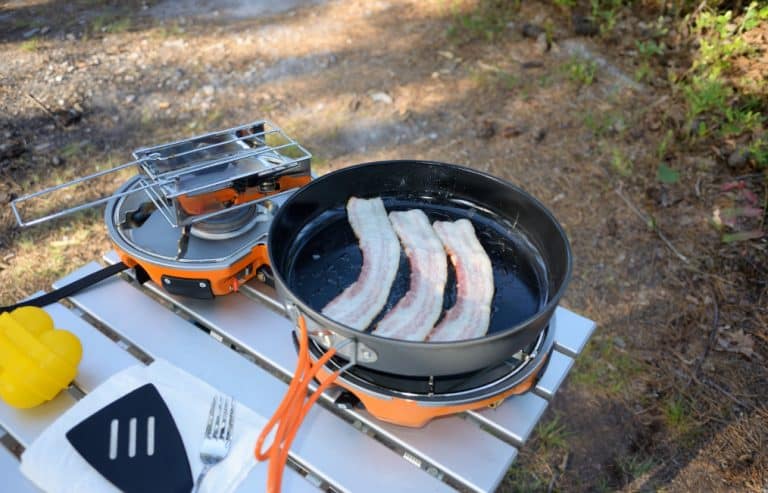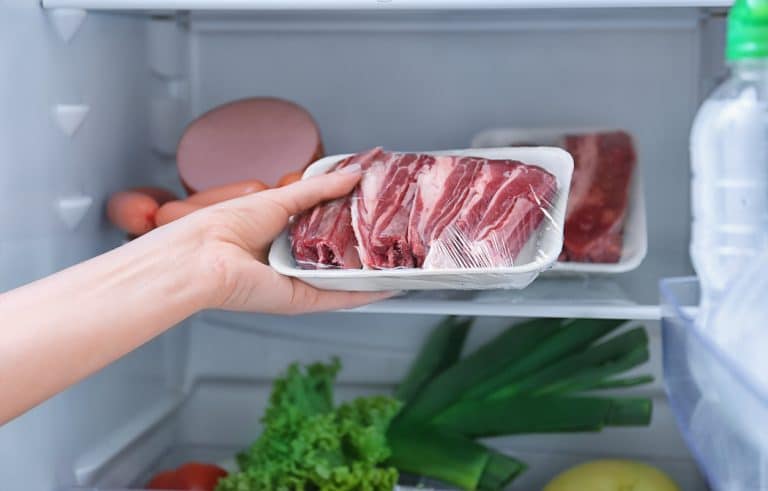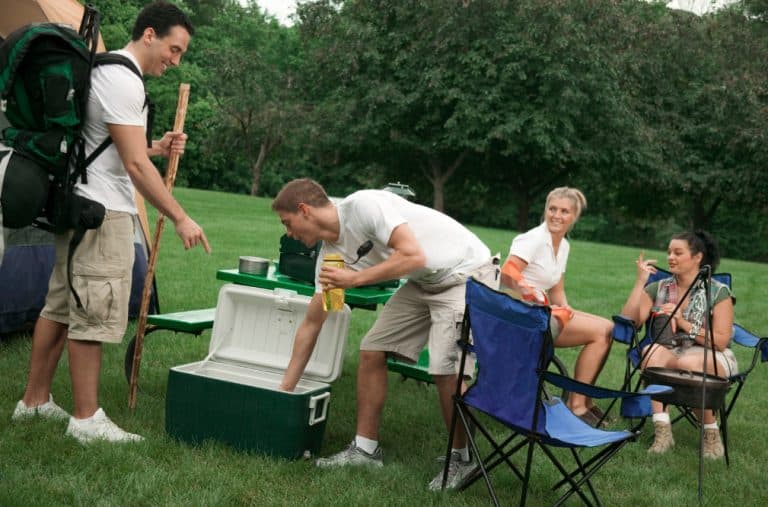A reliable camping stove is an essential piece of equipment for any outdoor enthusiast. From weekend campers to seasoned backpackers, a good camping stove makes mealtime more enjoyable and efficient. In this comprehensive guide, we’ll cover various types of camping stoves, their features, and tips for choosing the perfect stove for your next adventure.
Camping stoves come in different shapes, sizes, and fuel types. Understanding the various options will help you determine the best stove for your needs. Here are the most common types of camping stoves:
Canister Stoves
Canister stoves are among the most popular types of camping stoves due to their ease of use, portability, and versatility. They are designed to connect directly to pre-pressurized, self-sealing fuel canisters, which typically contain a blend of propane and isobutane. Here’s what you need to know about canister stoves:

Advantages of Canister Stoves
- Easy to use: Canister stoves are incredibly user-friendly. All you need to do is attach the stove to the fuel canister, turn the valve, and light the burner. There’s no need for priming or pumping.
- Lightweight and compact: Many canister stoves are designed with backpackers in mind, so they tend to be lightweight and packable. Some models even fold down to fit inside your cookware.
- Fast boil times: Canister stoves generally have high heat output, resulting in fast boil times. This can be particularly valuable when you need a quick meal or hot drink.
- Precise heat control: Most canister stoves have adjustable flame control, allowing you to cook a variety of meals with ease. You can simmer, boil, or sauté with precision.
Disadvantages of Canister Stoves
- Fuel canister waste: One of the main downsides of canister stoves is the waste generated by disposable fuel canisters. While some recycling programs accept empty canisters, they are not universally recyclable.
- Performance in cold temperatures: Canister stoves’ performance can decline in cold temperatures, as the pressure inside the fuel canister drops. Some models come with a pressure regulator to mitigate this issue, while others can be paired with a remote canister that allows the fuel to be inverted for better performance in cold weather.
- Fuel availability: While fuel canisters are widely available in outdoor stores and online, they may be more challenging to find in remote locations or international destinations. It’s essential to plan accordingly and stock up on fuel if you’re traveling to a remote area.
Tips for Using Canister Stoves
- Store canisters properly: Keep fuel canisters in a cool, dry place away from direct sunlight. Avoid storing them in hot cars or near heat sources, as extreme heat can cause the canister to rupture.
- Monitor fuel levels: It can be challenging to determine how much fuel is left in a canister. Some canisters are transparent, allowing you to see the remaining fuel, while others require you to shake or weigh them to estimate the remaining fuel. Always carry a spare canister to ensure you don’t run out of fuel during your trip.
- Use a windscreen: Although canister stoves are relatively wind-resistant, using a windscreen can improve their efficiency by protecting the flame from wind gusts. Be cautious not to fully enclose the canister within the windscreen, as it can cause the canister to overheat and potentially rupture.
- Maintain your stove: Regularly inspect your canister stove for any signs of wear or damage. Keep the burner clean and free of debris to ensure optimal performance. Replace O-rings and other components as needed to maintain a secure connection between the stove and fuel canister.
Liquid Fuel Stoves
Liquid fuel stoves are versatile and reliable camping stoves that run on a variety of liquid fuels, such as white gas, kerosene, diesel, or unleaded gasoline. They are known for their robust performance in different conditions and are particularly popular among backpackers, mountaineers, and winter campers. Here’s what you need to know about liquid fuel stoves:
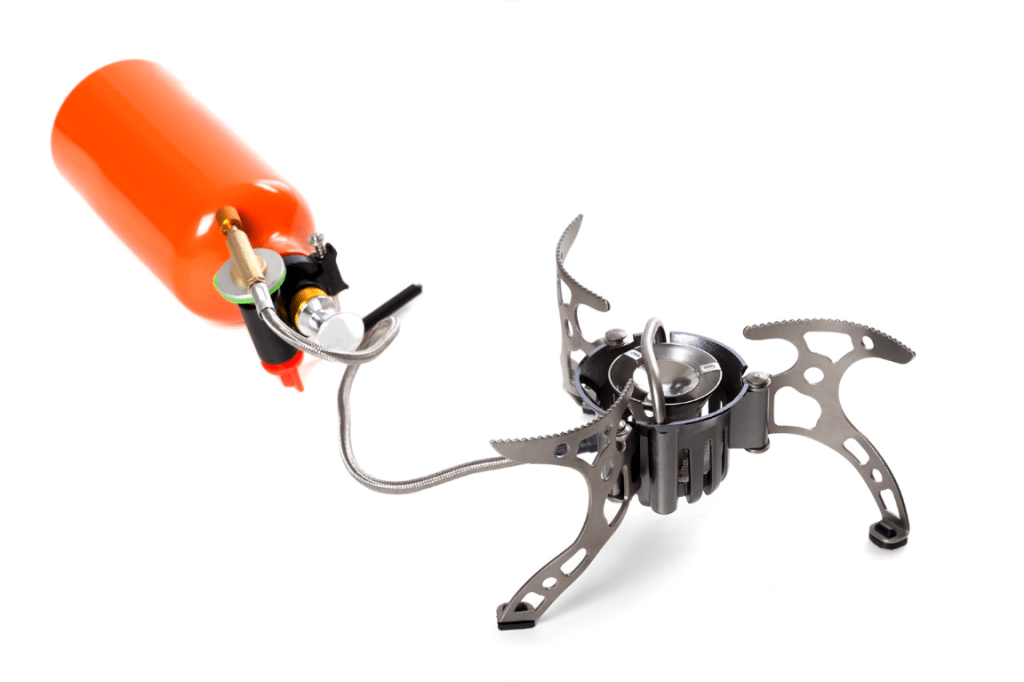
Advantages of Liquid Fuel Stoves
- Performance in cold temperatures: Liquid fuel stoves perform well in cold weather, making them a popular choice for winter camping and high-altitude mountaineering. The fuel does not lose pressure in cold temperatures, ensuring consistent performance.
- Fuel availability: Liquid fuel stoves can use a variety of fuel types, making it easier to find fuel in remote locations or international destinations. White gas, the most common fuel type, burns cleanly and efficiently, while other fuels like kerosene or unleaded gasoline are more readily available in certain areas.
- Eco-friendly: Unlike canister stoves, liquid fuel stoves use refillable fuel bottles, reducing waste from disposable fuel canisters. This makes them a more environmentally friendly option.
- Powerful and efficient: Liquid fuel stoves generally provide powerful and consistent heat output, allowing for fast boil times and efficient cooking.
Disadvantages of Liquid Fuel Stoves
- More complex setup: Liquid fuel stoves require priming and pumping, which can be more complicated than simply connecting a canister stove to a fuel canister. The learning curve may be steeper for inexperienced users.
- Maintenance: Liquid fuel stoves often require more maintenance than canister stoves, such as cleaning the fuel line, replacing O-rings, and maintaining the pump. Regular care is essential for optimal performance.
- Potential for spills and leaks: Since liquid fuel stoves use refillable fuel bottles, there is a risk of fuel spills or leaks. It’s crucial to handle fuel carefully and ensure that connections are secure to minimize this risk.
Tips for Using Liquid Fuel Stoves
- Choose the right fuel: While liquid fuel stoves can run on multiple fuel types, white gas is the preferred choice for its clean-burning properties and high heat output. Use other fuels like kerosene or unleaded gasoline when white gas is not available, but be prepared for increased maintenance due to residue buildup.
- Prime the stove correctly: Priming your liquid fuel stove is an essential step to ensure proper ignition and performance. Follow the manufacturer’s instructions for priming to avoid flare-ups or damage to the stove.
- Regular maintenance: Clean your stove regularly, paying particular attention to the fuel line and jet. Replace worn or damaged parts as needed, and carry a maintenance kit with spare parts during extended trips.
- Use a windscreen: Like canister stoves, liquid fuel stoves can benefit from using a windscreen to protect the flame from wind gusts and improve efficiency. Ensure that the windscreen allows for proper ventilation to avoid overheating the stove.
Alcohol Stoves
Alcohol stoves are lightweight, simple, and easy-to-use camping stoves that run on denatured alcohol, ethanol, or other alcohol-based fuels. They are popular among ultralight backpackers and minimalist campers due to their simplicity and low weight. Here’s what you need to know about alcohol stoves:
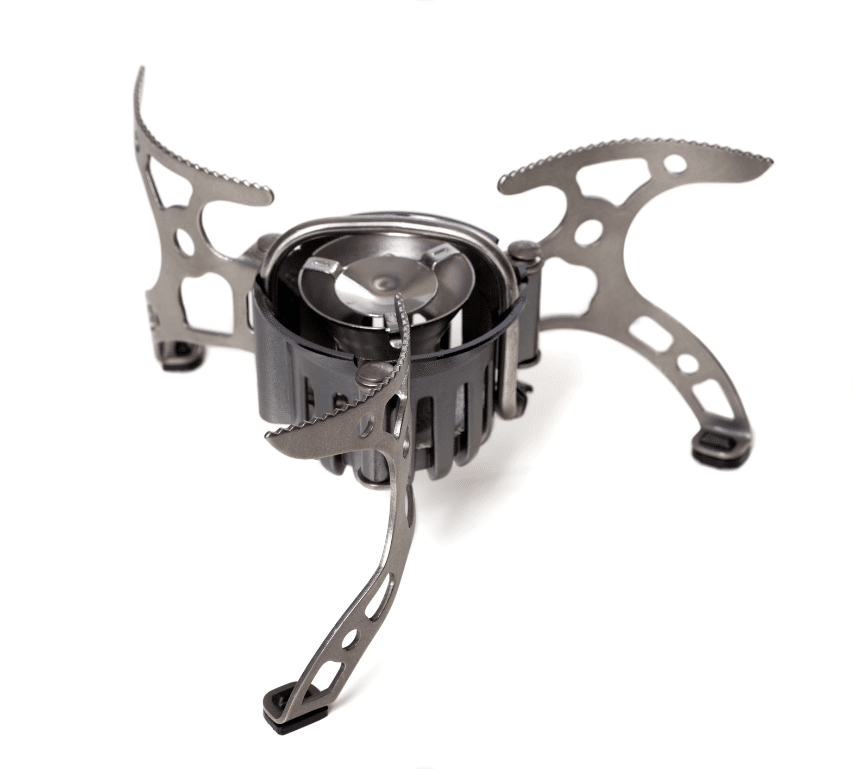
Advantages of Alcohol Stoves
- Lightweight and compact: Alcohol stoves are usually the lightest and most compact camping stoves available, making them an attractive option for weight-conscious backpackers and minimalist campers.
- Simplicity: With no moving parts, alcohol stoves are incredibly simple to use and maintain. They typically consist of a small burner and a container for the fuel, and they require minimal setup and maintenance.
- Quiet operation: Unlike other types of camping stoves, alcohol stoves are virtually silent, allowing for a peaceful cooking experience.
- Fuel availability: Alcohol stoves run on various types of alcohol, such as denatured alcohol, ethanol, or even isopropyl alcohol in some cases. These fuels are typically easy to find in hardware stores, supermarkets, or pharmacies.
Disadvantages of Alcohol Stoves
- Lower heat output: Alcohol stoves generally have a lower heat output compared to other types of camping stoves, which translates to longer cooking times. This might be a drawback for those who prioritize fast cooking or need to melt snow for drinking water.
- Less control over flame: Alcohol stoves often have limited flame control, making it challenging to achieve precise temperature regulation for certain types of cooking, such as simmering or sautéing.
- Fuel inefficiency: Alcohol stoves tend to be less fuel-efficient than other types of camping stoves, meaning you may need to carry more fuel for extended trips.
- Susceptibility to wind: Alcohol stoves can be sensitive to wind, which may require the use of a windscreen to protect the flame and improve efficiency.
Tips for Using Alcohol Stoves
- Choose the right fuel: While alcohol stoves can run on various alcohol-based fuels, denatured alcohol and ethanol are the most common and efficient options. Avoid using methanol or isopropyl alcohol, as they produce toxic fumes and soot when burned.
- Use a windscreen: To protect the flame from wind and improve the stove’s efficiency, use a lightweight windscreen specifically designed for alcohol stoves. Ensure proper ventilation to avoid overheating.
- Measure fuel accurately: Since alcohol stoves have no flame control, it’s essential to measure the amount of fuel needed for each cooking task. This will help conserve fuel and avoid wasting it.
- Practice safe handling: Alcohol fuels can be challenging to see when burning, especially in daylight. Take care when using an alcohol stove to avoid accidental burns, and never add fuel to a burning stove.
Wood Stoves
Wood stoves, also known as biomass stoves, are camping stoves that use wood, twigs, leaves, or other organic materials as fuel. These stoves are popular among campers seeking a more sustainable and self-sufficient option for outdoor cooking. Here’s what you need to know about wood stoves:
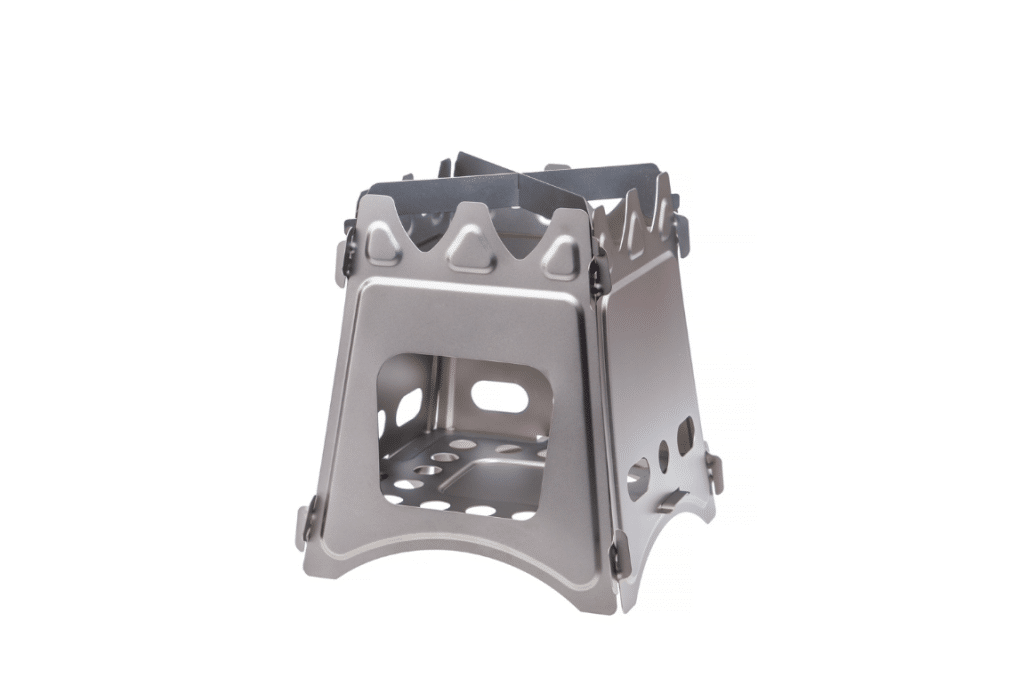
Advantages of Wood Stoves
- Eco-friendly and sustainable: Wood stoves use renewable resources for fuel, making them an environmentally friendly option. By using small twigs and branches found on the ground, you can reduce your reliance on non-renewable fuel sources like gas canisters.
- Fuel availability: Since wood stoves use organic materials like twigs, leaves, and pinecones as fuel, you won’t have to worry about running out of fuel or carrying extra weight in the form of fuel canisters. This makes them an attractive option for extended trips in wooded areas.
- Versatility: Some wood stoves are designed to work with other fuel types, such as alcohol or solid fuel tablets, providing additional flexibility in fuel options.
- Cost-effective: With no need to purchase fuel canisters, using a wood stove can save money over time.
Disadvantages of Wood Stoves
- Slower cooking time: Wood stoves typically take longer to heat up and cook food compared to gas or liquid fuel stoves. This can be a drawback for those who prefer faster cooking times.
- Inconsistent heat output: The heat output of a wood stove can vary depending on the type and quality of the fuel used, making it harder to control cooking temperatures.
- Smoke and soot: Wood stoves can produce smoke and soot, which may be a concern for those with respiratory issues or who want to keep their cookware clean.
- Limited usability in some areas: Wood stoves may not be suitable for use in areas with limited fuel sources, such as alpine environments or places with strict fire regulations.
Tips for Using Wood Stoves
- Gather dry fuel: To ensure efficient burning, collect dry twigs, branches, and leaves for fuel. Avoid using wet or green wood, as it produces more smoke and takes longer to burn.
- Use a windscreen: Just like with other types of camping stoves, using a windscreen with a wood stove can help protect the flame and improve efficiency.
- Practice Leave No Trace principles: Always follow Leave No Trace principles when using a wood stove, which includes minimizing the impact on the environment and properly disposing of ashes.
- Maintain your stove: Clean your wood stove regularly to remove soot and debris, ensuring optimal performance and reducing the risk of fire.
- Be aware of fire restrictions: Always check for fire restrictions and regulations in the area where you plan to camp. Some locations may not allow the use of wood stoves due to the risk of wildfires.
Solid Fuel Stoves
Solid fuel stoves are a type of camping stove that use solid fuel tablets or blocks as their primary fuel source. These stoves are lightweight, compact, and often more affordable than other stove types. Here’s what you need to know about solid fuel stoves:
Advantages of Solid Fuel Stoves
- Lightweight and compact: Solid fuel stoves are typically small and lightweight, making them an excellent option for backpackers or those looking to minimize their gear weight.
- Easy to use: These stoves are simple to operate, with no moving parts or complicated mechanisms. You simply light the fuel tablet and place your pot or pan on top of the stove.
- Affordable: Solid fuel stoves are generally less expensive than other stove types, and the fuel tablets are also relatively inexpensive.
- Stable and wind-resistant: Due to their low profile and simple design, solid fuel stoves are less affected by wind compared to other stove types.
Disadvantages of Solid Fuel Stoves
- Limited heat control: Solid fuel stoves offer little to no control over the heat output, making them less suitable for tasks that require precise temperature control, such as simmering or frying.
- Slower cooking times: The heat output of solid fuel stoves is generally lower than gas or liquid fuel stoves, resulting in longer cooking times.
- Limited fuel availability: Solid fuel tablets may not be as widely available as other types of camping stove fuels, so it’s essential to plan ahead and stock up before your trip.
- Waste generation: Solid fuel tablets leave behind residue after burning, which must be properly disposed of to minimize environmental impact.
Tips for Using Solid Fuel Stoves
- Use a windscreen: Although solid fuel stoves are more wind-resistant than other stove types, using a windscreen can further improve their efficiency.
- Preheat water or food: To save fuel and reduce cooking time, consider preheating water or food in a separate container before transferring it to the stove.
- Clean your stove: Regularly clean your solid fuel stove to remove residue and ensure optimal performance.
- Be mindful of ventilation: Solid fuel tablets can produce fumes, so it’s essential to use them in a well-ventilated area.
- Practice Leave No Trace principles: As with all camping stoves, adhere to Leave No Trace principles, including properly disposing of any waste or residue from solid fuel tablets.
Overall, solid fuel stoves are a lightweight and straightforward option for campers who prioritize simplicity and weight reduction. However, they may not be the best choice for those who need precise temperature control or faster cooking times.
Features to Consider When Choosing a Camping Stove
Features to Consider: When choosing a camping stove, consider the following features to find the perfect match for your needs:
- Fuel Type: The type of fuel your stove uses will impact its performance, weight, and convenience. Consider factors like availability, cost, and environmental impact when choosing a fuel type.
- Weight and Size: For backpacking or hiking trips, a lightweight and compact stove is essential. Car campers or larger groups may prefer a more substantial stove with multiple burners for added convenience.
- Burner Power: Measured in BTUs (British Thermal Units), burner power indicates how much heat a stove can produce. Higher BTUs mean faster cooking times and better performance in windy conditions.
- Simmer Control: Some stoves offer precise flame control, allowing you to simmer food at low heat or bring water to a rolling boil. This feature is essential for gourmet camp cooks or those who prefer more control over their cooking.
- Wind Resistance: Wind can significantly impact a stove’s performance. Look for stoves with built-in windshields or purchase a separate windscreen to protect the flame and conserve fuel.
- Ignition Type: Some stoves feature an integrated piezo igniter, which eliminates the need for matches or a lighter. While this feature adds convenience, it may not be as reliable as traditional ignition methods.
Tips for Choosing the Perfect Camping Stove
- Assess Your Needs: Consider the type of camping you do, the size of your group, and your cooking preferences. Solo backpackers may prefer a lightweight, compact stove, while larger groups or car campers may opt for a more powerful, multi-burner stove.
- Budget: Camping stoves range widely in price. Determine your budget before shopping, and remember that a higher price doesn’t always mean better performance. Sometimes, a more affordable option may suit your needs just as well.
- Fuel Availability: If you’re planning an extended trip or traveling internationally, ensure that your stove’s fuel type is readily available in your destination. Liquid fuel stoves are often the most versatile in this regard.
- Cooking Style: Think about the types of meals you plan to cook while camping. If you enjoy preparing elaborate meals, a stove with multiple burners and precise heat control may be more suitable. If you primarily boil water for freeze-dried meals or coffee, a simple, lightweight stove may be sufficient.
- Environmental Impact: Some campers prioritize eco-friendliness when selecting a stove. Wood-burning stoves have the lowest environmental impact, while canister stoves generate waste in the form of disposable fuel canisters. Liquid fuel stoves can be a more eco-friendly option, as their fuel bottles are refillable.
Safe
When camping, it’s crucial to exercise caution and adhere to safety measures while using stoves to prevent accidents and protect the environment. Always set up your stove on a stable, level surface, away from flammable materials such as dry leaves or tent fabric. Ensure proper ventilation to avoid carbon monoxide buildup, which can be hazardous in enclosed spaces. Keep a fire extinguisher or water source nearby to tackle any unexpected flare-ups, and never leave a lit stove unattended. Additionally, follow Leave No Trace principles by minimizing your impact on the environment, cleaning up after cooking, and disposing of fuel canisters or waste responsibly. By being vigilant and safety-conscious, you can enjoy a pleasant and secure cooking experience while camping.
Conclusion
Selecting the perfect camping stove is essential for a comfortable and enjoyable outdoor cooking experience. By understanding the various types of stoves, their features, and how they align with your specific needs, you can make an informed decision that will enhance your camping adventures. Follow the tips in this guide to choose, use, and maintain your camping stove for years of memorable meals in the great outdoors.
Camping Stoves FAQs
Backpackers often prefer canister stoves and alcohol stoves due to their compact size and lightweight design.
Liquid fuel stoves are the best option for high-altitude cooking and cold weather conditions because they offer consistent performance and better fuel efficiency in such environments.
Compare the BTU output and fuel consumption rates of various stoves, and consider factors such as heat control, wind resistance, and the type of cooking you plan to do.
Wood stoves, which use renewable biomass, are an eco-friendly option. Additionally, some stoves are designed to burn fuel more efficiently, reducing emissions and fuel consumption.
Always follow the manufacturer’s guidelines for proper use, setup, and maintenance. Choose a stove with safety features such as locking mechanisms and stable supports for pots and pans.
Multi-burner stoves allow you to cook multiple dishes simultaneously, making them ideal for larger groups or campers who require extensive cooking capabilities.
Solid fuel stoves have limited heat control, making it challenging to perform tasks that require precise temperature control, such as simmering or frying. Other stove types, like canister or liquid fuel stoves, offer better heat control for these tasks.
